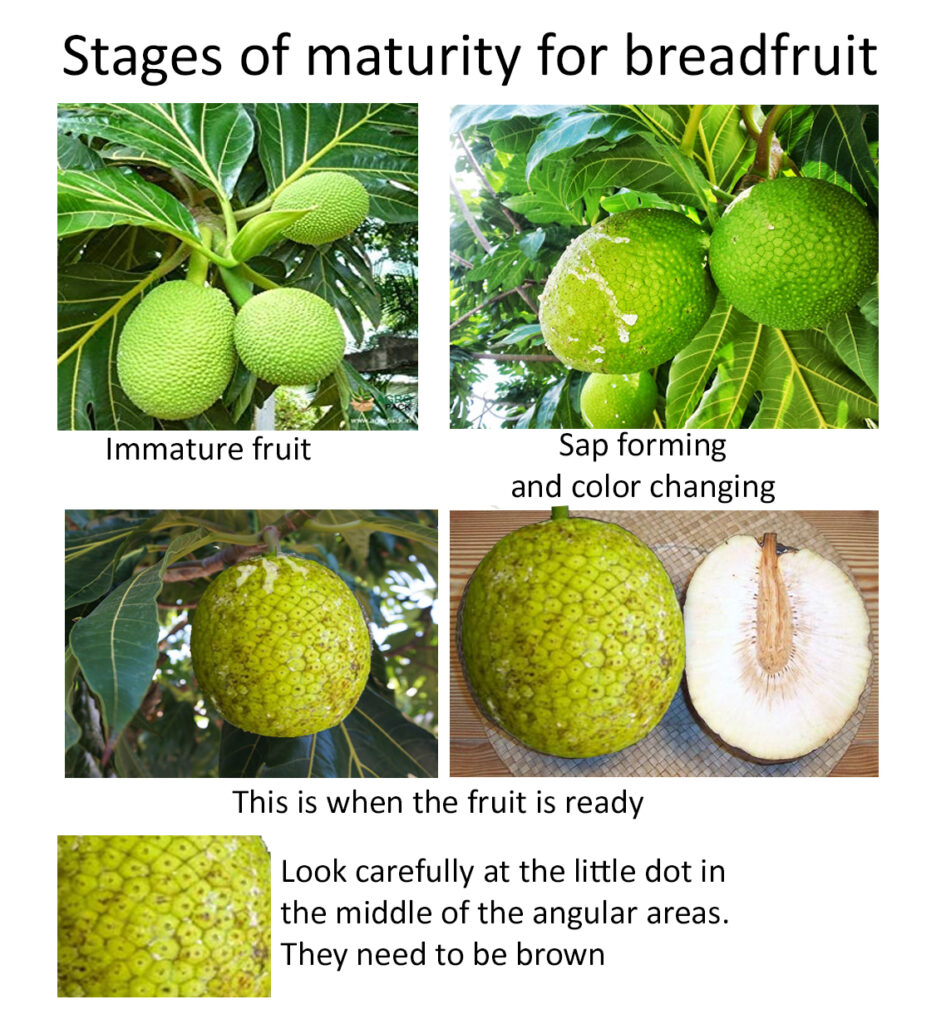Tree Care
Water, soil, and sun! While trees require less labor than other annual crops, they still needed to be cared for.
Click Here to check out our starter guide on how to plant a fruit tree.
After three to five months in a nursery, TTFF breadfruit trees are ready to be distributed. They will be about 45cm (18in.) high, with a 1.25cm (0.5in.) stem, and three to four healthy leaves. The map below illustrates areas in the world that are suitable for breadfruit cultivation. The best groves will come from well-tended young plants that are carefully monitored in their youth by attentive growers. Be aware that the most common cause of death for breadfruit trees is drying out. When you receive your trees, they will be in grow bags. Be sure to:
*Water plants daily
*Keep plants in partial shade
*Transplant within 30 days
*Inspect plants every day
Watering: Prior to transplanting, trees should be watered in early morning and checked in the afternoon to make sure soil hasn’t dried out. If completely dry, water again. Best watering practice is ensuring that plants do not have wet leaves from manual irrigation during the night, as this can promote growth of disease organisms.
Transplanting: Trees may be planted on slopes as well as flat lands. The recommended planting distance for a pure-stand orchard is 9m X 9m (30ft. X 30ft.) and for an agro forest is 12m X 12m (40ft. X 40ft.).
1. Holes should be twice as deep and twice as round as the potting container.
2. Circle spray hole with small amount of fertilizer (low N-P-K ratio).
3. Center plant in hole.
4. Fill with remaining soil mix of field soil and planting soil, compost, manure, or any other soil additive.
5. Firm around base of plant.
6. Mulching a slight basin around each plant after planting is very helpful to ensure water is directed to the roots and not lost to runoff.
Where irrigation is not possible, transplant at the end of the dry season or beginning of the rainy season. Use nitrogen fertilizer for the first six months. Intercropping may be practiced in the first three years.

Watering in Ground: Regular thorough watering is necessary. If the dry season is unusually long or plants show symptoms of stress, such as lower-leaf drop or scorching of leaf edges, manual watering will be essential.
Fertilizer: Fertilize your trees seasonally with either a commercial granular fertilizer with aged organic matter or compost. Fertilize each time trees are pruned. *It is more important to revitalize the soil by mulching, cover crops (legumes), and compost or aged manure.
Pests/Disease: If trees are healthy and you have maintained proper sanitation by removing fallen fruit, disease problems should be minimal. Possible enemies to watch out for include: fruit flies, whiteflies, mealy bugs, snails, slugs, Botrytis, and mildews. Bees from managed bee colonies nearby may also cause severe damage to the fruit. Particular attention must be paid to protection from grazing animals, such as goats.
Pruning: Prune once each year after finished fruiting and before growth stage begins. Follow pruning with fertilizer, mulch, and compost. Begin when tree is two to three years old. Keep height at 4.5m–5.5m (15–18ft.) to make harvesting fruit easier. Canopy spread should be 1.8-2.4m (6-8ft.). Pruning increases productivity.
Fruit: Trees will show fruit in the first two years. Your first economic crop should be in year three. Optimal fruiting is reached at the age of five to six years. You will see sap on the outside of the fruit when it is ripe. Remove fallen fruit from the ground before it rots. Mature fruit that falls can be consumed within two days.
Harvest: Typically, you will harvest twice each year. It is important that the entire fruit stalk is removed with the fruit. Climb and hand pick if possible. Otherwise, use a 3-5m (10-16ft.) long picking tool while standing on the ground. You will also need a net basket. Harvest in the early morning and keep the fruit in the shade. It should be cooled rapidly where air can be circulated among the fruits in post-harvest processing. Containers for carrying and transporting the fruit must be sturdy and well-ventilated. Do not put more than two layers of fruit in a container, and do not use bags. Plan to harvest 16-20 weeks from the time you first see tiny fruit emerging. Timing depends on how you plan to use the fruit: 16 weeks is best for shipping and storage (skin should be bright green with beginning of stain, smoothing surface, little segments on the surface should be expanded); 18 weeks is best for a range of different uses (mature fruit is turning from green to green-yellow and skin changes from pointy or bumpy to smooth); 20 weeks is best for chef or consumer, when the fruit is soft, sweet, and ripened (turning brown).
Trees can produce 175-300 fruits over the course of a year during multiple harvests. With ideal care and attention, they can continue fruiting for 50 years or more.
Post-Harvest Handling: Breadfruit is very perishable once it is fully mature. Without refrigeration or hydro-cooling, the fruit deteriorates within two to three days. Shelf-life can be extended by cool storage.



